From El Sargento and La Ventana, you can watch shadows paint Isla Cerralvo a changing hew of colors from sunrise to sunset. The island provides beautiful views, but it also conceals many tales. The Caballera de Cerralvo, told here for the first time, is one of them.
Continue reading “La Caballera de Cerralvo”La Ventana Stories
Sierra de la Laguna, Part 2

Sierra de la Laguna, Part 2: When I got to camp, it was nearly empty, and I realized that my dad and the guide were not there yet. After an hour or so, they arrived. At this point, I was starving, and was super excited to cook my freeze-dried pasta primavera, but sadly realized that the fire would be occupied by the camp guides for the next three hours. This was disheartening, to say the least. That evening, I did finally get to indulge in my pasta, though I realized I had been majorly over-excited about it, since it really wasn’t that great.
Early the next morning, my friends and I left early. Our guide said we could go, but cautioned us not to explore the valley, as it was huge and we could get lost. We made good time. The first part of the hike was extremely steep, but it soon leveled out and we hiked among beautiful high-elevation pine forests full of small Black-Tailed Brush Lizards. Around midday, we arrived at the valley, a sizable meadow with meandering streams criss-crossing it. I could tell immediately that I would love it there.
The valley was surrounded by tall trees and rock piles, and these rocks continued onto the edge of the valley, which seemed not quite as large as I had expected. I walked around the edge for a while, flipping rocks, and then, under a large rock, I found my first-ever San Lucan Alligator Lizard, which would prove to be the first of many up in the valley. They are fascinating lizards that sometimes move in a snake-like way, wiggling through the grass, with very long tails. They live primarily up in the mountains of Baja. After that first one, my friends and I found probably 10 more.
I then reached the opposite side of the valley, where a narrow strip of meadow connected us to a HUGE meadow. We had merely experienced the pinky toe of the valley, and this Blew My Mind! I headed out into this new meadow, saw a very good flat, large rock, flipped it, then saw another one, flipped it, and so on. After about half an hour of this, I turned around and started heading back. After a minute of walking, it dawned on me that I didn’t recognize anything. Wait, which way was camp? – If you want to talk or walk reptiles, email ChanceStevens123@icloud.com
Sierra de la Laguna: Part 1
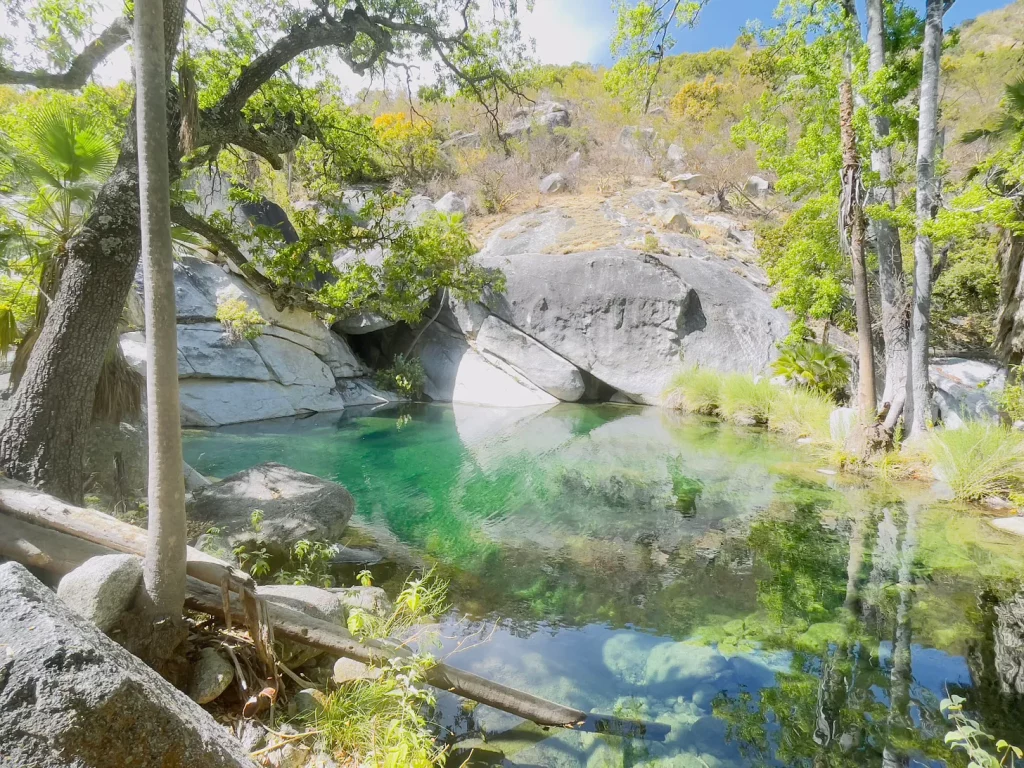
Sierra de la Laguna: Part 1. In early March, some friends, my dad and I had an adventure hiking the highest mountain in BCS in search of rare reptiles.
This mountain in the Sierra de la Laguna Mountain Range is known as the Cima de la Sierra, although you can’t even see the Cima until you are already high in the mountains. This four-day backpacking trip ended up being an incredible experience, despite the many ups and downs (ha ha, literally). Anyway, this will be a three-part series describing that adventure and what we found on it.
The day before it all started was a scramble to get on the road, as usual. However, unlike usual, we were able to depart only about an hour behind schedule. By evening we had made it to Rancho San Dionisio, which is essentially on the trailhead. We spent the night there and made it onto the trail by mid-morning. The first hour was quite pleasant, and we were in good spirits.
I was very excited, as our first camp was going to be at a beautiful swimming hole. I was also excited because I was going to have a freeze-dried pasta primavera for lunch, among our freeze-dried food assortment. Unfortunately, due to a miscommunication, our cookstove was left in the truck. Our guide insisted we would have fires to cook on and we already had way too much stuff, so it was left behind. That would prove to be a grave mistake.
The trail then changed, and we were now trekking up a steep hill. After about five hours of hiking up a mountain in 85-degree weather, we finally arrived at the beautiful swimming hole surrounded by stunning rock lizards. After freezing half to death in the tropical desert ice water, I headed up to camp to have lunch but, when I got there…
To be continued next week in All Things Reptile! If you want to talk or walk reptiles, email ChanceStevens123@icloud.com
Common Dolphin
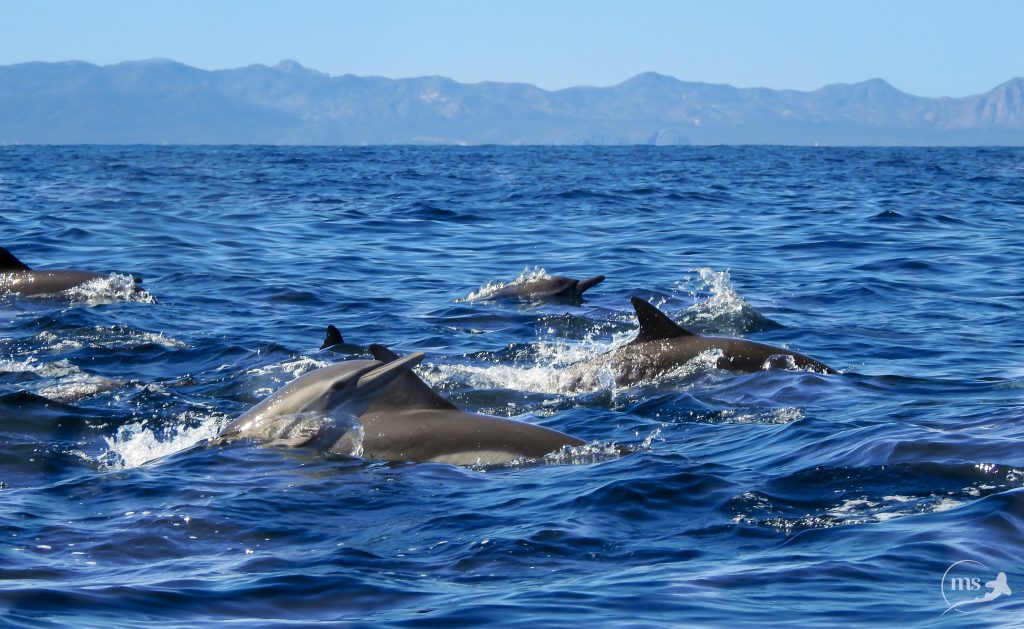
Common dolphins (Delphinus delphis) are the most common cetacean in the world, they are found worldwide, through tropical and temperate waters, nearshore and offshore. Despite their name, they are not the dolphin we have in mind as the “classic dolphin”, being this one the bottlenose dolphin, popular in media or aquariums. Common dolphins have a well-defined long beak, a black-grey back, and a dark patch around the eye, they can be easily recognized by a pale to tan hourglass or crisscross pattern on the sides of their bodies.
They form large groups for hunting and socializing, it is not rare to see hundreds of them in a group. Sometimes, they can form bigger groups called “super pods”, gathering thousands of individuals. They are very playful when they swim in groups and enjoy breaching and playing with waves, they are known for swimming along with boats, either racing at the front or playing at the wake that is formed behind.
Because of their wide distribution, they have a varied diet, feeding on schooling fish like anchovies and sardines, among other species, and enjoy eating squid too. They have been recorded to make dives up to 200 meters (660 ft) deep.
Recently we had big groups of common dolphins in the bay, and what is even better: there were many babies with them! Given that newborn calves measure 7 to 100cm (2.3 to 3.3 ft) I would say these babies were recently born, I had never seen such
Cliffhanger
This week, for All Things Reptile, I will be leaving you on a cliffhanger. I just returned from a major trip and need time to recover. (Next week! I promise.) For now, here is a link to the video that I submitted to the Baja Film Festival, in case you missed it. Congratulations, Prof. Bird! If you want to talk or walk reptiles, email ChanceStevens123@icloud.com
Spring Snake Emergence
It is now late winter, and the weather patterns are starting to shift. As it warms up, the reptiles wake. It is a magical (for me) time of year, because the spring snake emergence will soon be upon us.
Snakes are mysterious and elusive creatures. Throughout the winter, they are typically very hard to find, mostly because they are cold blooded and need heat to operate properly. In many parts of the USA and all of Canada, snakes have to find deep holes in the earth to get below the frost line. In contrast, here in Baja it never gets that cold, and snakes can spend the winter in rodent burrows, root systems and under rocks. They will even occasionally come out to bask in the sun rays throughout the winter.
Now that it is warming up, many snakes will come out to find food and soak up the sun. If you are scared of snakes, you need not worry, since the vast majority here are completely harmless.
The main place you will notice this snake emergence is on hiking and biking trails. You may worry about the snakes hurting you yet, realistically, you are a Far Bigger Danger to the snakes. All I ask — particularly in this season — is to please be careful when driving through the desert, or even mountain biking. Snakes are very vulnerable to cars and, unfortunately, they like sitting on roads.
Next week I will bring to you… drumroll please… the tale of my reptile-inspired trip to the summit of the Sierra de La Laguna! If you want to talk or walk reptiles, email ChanceStevens123@icloud.com
Paper Nautilus or Argonaut
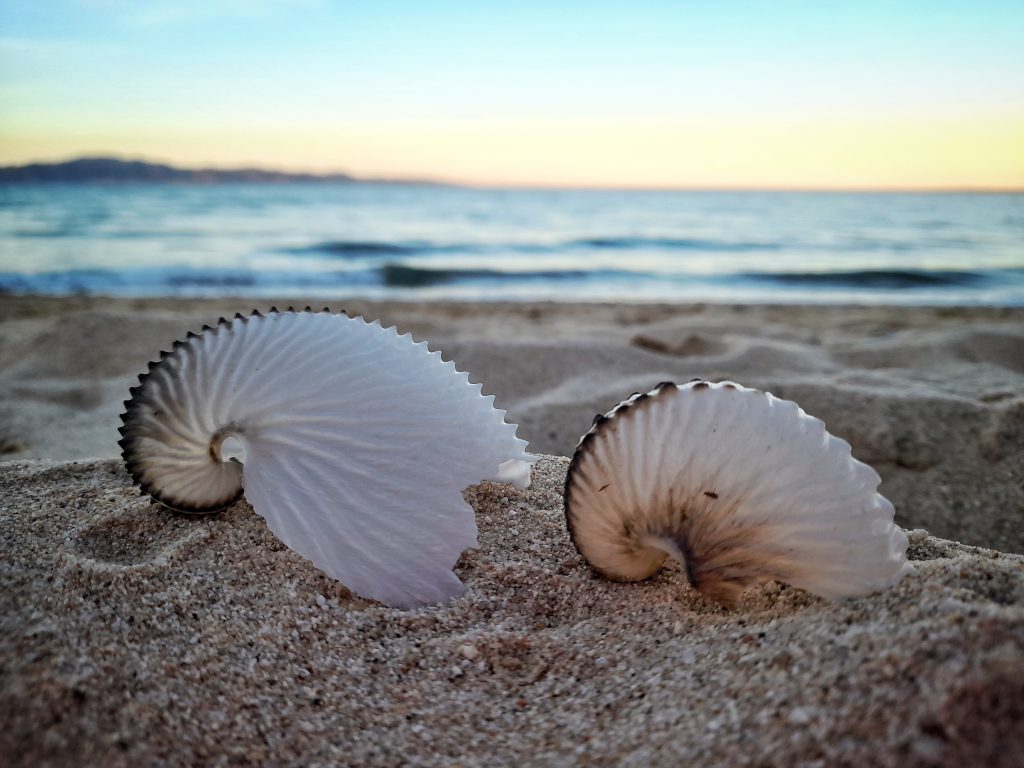
Today I want to introduce you to one of the most fascinating marine creatures. These beautiful and delicate shells you see, didn´t belong to a snail or a crab, they belonged to an octopus, a female octopus to be more precise.
Paper nautiluses or argonauts are a group of pelagic octopuses. Unlike their ground dwelling cousins, they spend their lives drifting in the water column, so they evolved in clever ways to adapt to this environment. Argonauts exhibit extreme sexual dimorphism in size, lifespan and features. Females can grow up to 30 cm (12 inches), with their shells while males rarely reach more than 2cm (0.8 inches). Males only mate once in their short lifetime, but females can reproduce many times during their lives. Females have been known since ancient times, because of a unique characteristic, while males were only described in the late 19th century.
The most particular feature of these animals belongs to females too: they have two special tentacles that secrete calcite. After mating, they start producing a delicate papery shell, lay their eggs inside it and get cozy themselves. They capture air at the surface and then seal it inside the shell, using it for buoyancy control, like a hot air balloon. They can control the size of the air bubble to keep their position in the water column. This way they travel, following the current accompanied by their eggs without expending energy.
A paper nautilus’ shell is a rare finding, if you are lucky to find one, treat it carefully, it’s a little and delicate treasure, a part of a creature with a unique life story!
San Lucan Rock Lizard
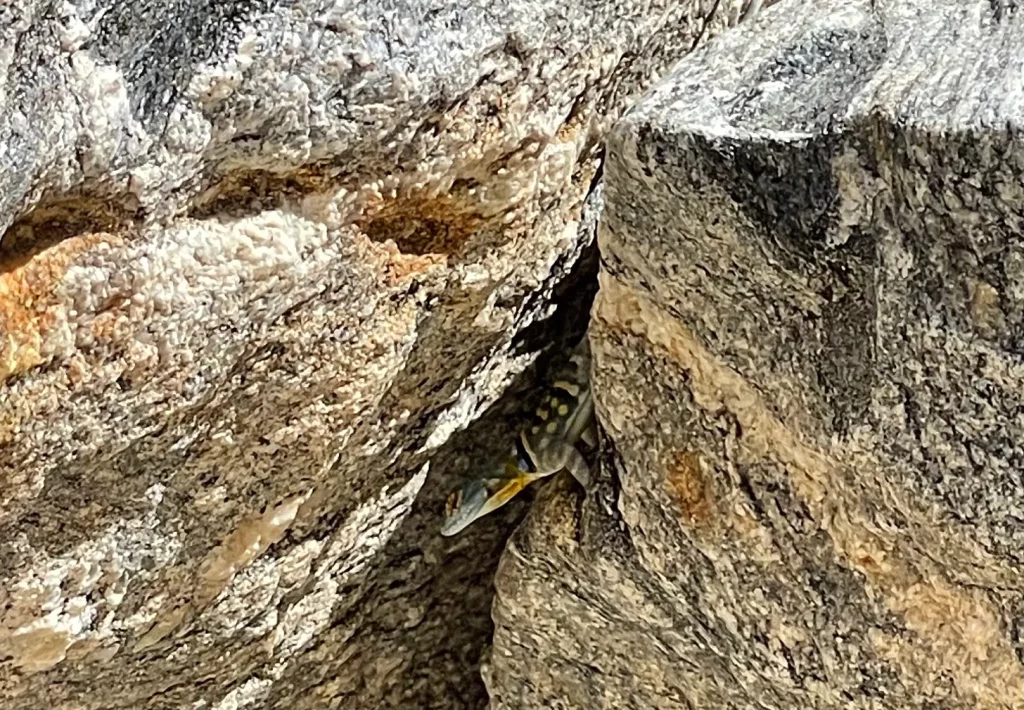
Today’s reptile spotlight features the San Lucan Rock Lizard (Petrosaurus thalassinus), a beautiful and skittish lizard that always seems to keep a distance from humans, posing with a superior aura, somewhat like many celebrities.
San Lucan Rock Lizards are some of the most striking lizards in Baja, without a doubt, with their beautiful blue collars and vibrant splotches. They love hanging out on large rocks and boulders in arroyos and along hillsides. Although they mostly inhabit higher elevations, they can be found in the hills above La Ventana on occasion. They are very fast and, though some are a bit more laid back, most usually never let you get within 10 feet of them; again, like some celebrities.
These fascinating lizards primarily eat bugs, although sometimes leaves, fruits, seeds and even smaller lizards are eaten. In my experience, if you want to see a a rock lizard, they are very abundant along the riverbanks of the active arroyos near Santiago BCS, and that is where I took this photo. If you want to talk or walk reptiles, email ChanceStevens123@icloud.com
Blue Whale
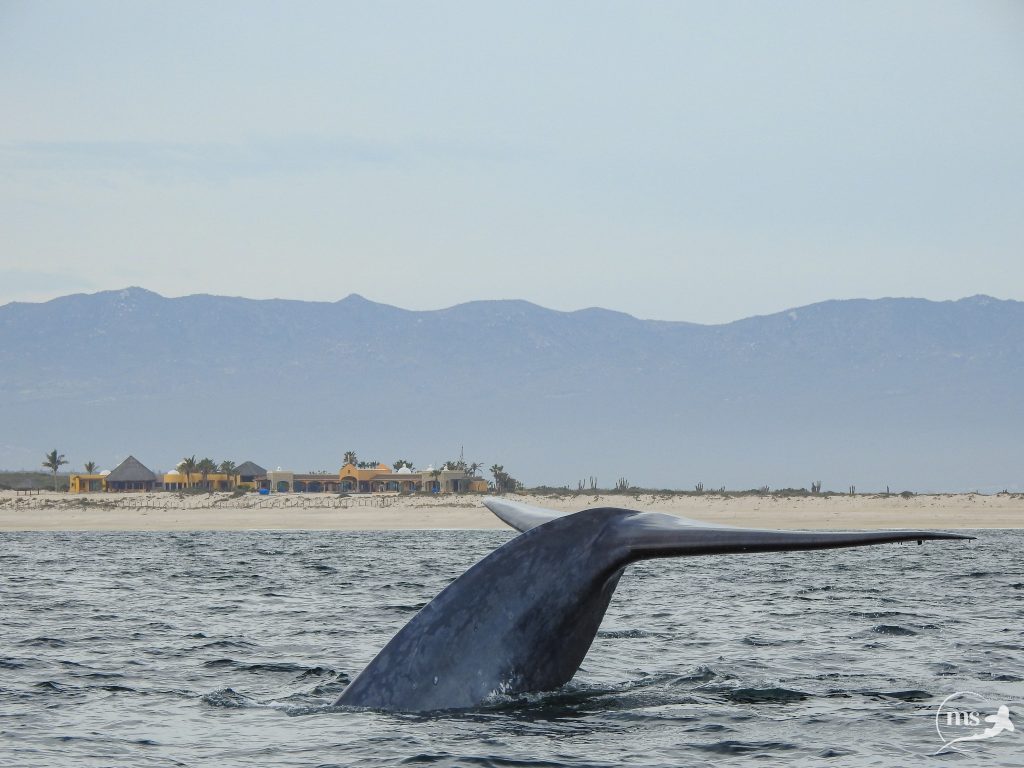
Just a few days ago we had an incredible encounter: while out on a boat, we found not one, but two blue whales in our bay. We were observing a humpback whale when suddenly, we heard a very loud blow close to our boat: there it was, a gigantic creature just at our doorstep. The sound of a blue whale´s breath is incredible, it is so loud it gets inside your chest, no doubt a powerful feeling to hear one close by.
Blue whales are the largest animal known to have ever existed. They can live up to 80 or 90 years and reach a maximum length of 30m (98 ft) and weigh up to 200 tons. Their heart is the size of a car! They perform long migrations, traveling from their summer feeding grounds in the polar regions to their winter breeding grounds in waters near the tropics.
Despite their size, much of their life story remains a mystery. They are generally solitary or gather in small groups, mothers with their calves being the most common aggregation. They migrate during winter and spring to the Gulf of California for feeding and breeding. In Loreto area, females with their newborn calves have been observed.
They are baleen whales, meaning they do not have teeth, but baleen plates that they use to filter their food. Their diet consists almost exclusively of krill. Their stomach can hold one ton of krill and they need to eat about 4 tons of krill each day.
Blue whales produce some of the loudest and lowest frequency vocalizations in the animal kingdom, and their inner ears appear well adapted for detecting low-frequency sounds. They emit a series of pulses, groans, and moans, and it’s thought that, in good conditions, blue whales can hear each other up to 1000 miles away. Scientists think they use these vocalizations not only to communicate but, along with their excellent hearing, to sonar-navigate the lightless ocean depths.
Like other whale species, they were abundant in nearly all the Earth´s oceans, until the 19th century, when they were hunted almost to extinction. The International Whaling Commission banned blue whale hunting in 1966, but they’ve managed only a minor recovery since then. Today they are listed as Endangered and face man-made threats such as ship strikes, pollution, ocean noise, and climate change.
The Yellow-Bellied Sea Snake
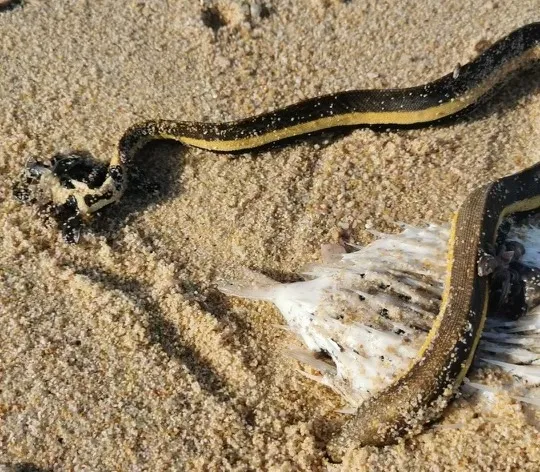
Today’s column features one of the most venomous reptiles inhabiting Baja. Besides the rattlesnakes, the Yellow-bellied Sea Snake (Hydrophis platurus) is the only dangerous snake in our region. Although they are not considered to live here, these curious, interesting and uncommon snakes do swim into the gulf from time to time. In the La Ventana area, though extremely rare, they can sometimes be seen around the reefs and even washed up onto the beach. I guess even sea snakes want to vacation here.
Most likely, if you have seen a long, snake-like creature in the water, it was an eel, which is a kind of fish. Many eels look so much like snakes that they get mis-identified frequently. To further complicate matters, some eels are called “snake eels” or even just “snakes.” For example, “tiger reef snakes” are actually eels.
Actual sea snakes are black and yellow, and eat eels. They are usually very non-aggressive, and quite reluctant to bite, although they are highly venomous and so should be treated with caution. In most cases, you will see them sitting on the beach, which indicates that they may be sick or weak, and not in their best state. Recently my friend Julie sent a photo of just one such unfortunate fellow on South Beach. Here is that photo. When sea snakes are in the water, however, they tend to be far more active and healthy. If you want to talk or walk reptiles, email ChanceStevens123@icloud.com